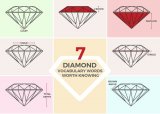
When we hear the word, “diamond”, the first thing that comes to mind is a big sparkling stone, all white, set atop a beautiful gold ring. Such solitaires are every woman’s fantasy and every man’sidea of a perfect gift for their partners. Highly precious and highly valued, diamonds have long fascinated mankind as objects of desire. When set in jewelry, these beauties turn heads and make lips go, “WOW!”
Hard Fact: From all the diamonds mined the world over, only about 20% actually get used in jewelry.
Yup, you read that right. Jewelry grade diamonds are only about 20% of the total diamonds mined around the world. The rest are either too dull or opaque or just downright financially unviable to be converted into the sparkling stones required for jewelry. Now before you start wondering what happens to the remaining 80% of the diamonds mined, know that diamonds are mainly classified into two kinds – jewelry grade and industrial grade.
While the jewelry grade diamonds are useful only as objects of desire, the industrial diamonds find multitude of uses in almost every technological sector across the globe. Wondering where? Let’s take a look…
High Quality Audio: I am sure you did not see that one coming. Unbelievable, but true.Apparently sound travels a lot faster in diamonds than it does in air. Furthermore, diamonds are unbelievably hard, so when they vibrate, they do not suffer wear and tear. When converted into a really slim dome, they can reproduce top quality sound without any distortion.
Industrial Abrasives:The ultimate combination of hardness and toughness of the diamonds make them ideal for a number of industrial applications such as grinding, polishing and cutting. After jewelry, perhaps the second highest use of diamonds is as abrasives. Extremely small diamonds or grinded diamond powderare installed into a number of tools including drill bits, grinding wheels, metal and diamond saws. Most of the diamond cutting and polishing tools themselves use such diamonds or diamond based powder. After all, only a diamond can cut a diamond.
Semiconductors: Diamond’s impressive chemical, thermal and electronic properties make it the ultimate semiconductor material. Due to diamond’s thermal conductivity, diamonds can tolerate extremely high temperature without getting too hot. Their ability to dissipate heat combined with ability to let electrons travel really fast, allow diamonds to tolerate high voltages before breaking down.
Engraving:Diamond is the hardest materialknown to man. There are several other hard metals and stones other than diamonds, but none come close to the hardness of diamonds. In other words, nothing can scratch the surface of diamonds. So, once again, diamonds are the natural choice for any kind of engraving on other materials. Be it quartz, granite or any other stones, diamonds are used to create beautiful styles, patterns, shapes and even to give them necessary finishingdesiredfor jewelry and other decorative applications.
Interesting Trivia: In earlier times, diamonds were believed to have medicinal properties, especially against poisons and certain deadly diseases such as the plague.
Bearings: When low friction is required, bearings are normally the chosen solution. But what if the bearings needed are really teeny weeny and cannot be changed frequently? Diamonds come in handy in such cases. Their high durability and resistance to abrasion make them just perfect for use in such micro ball bearings.
Diamond Coatings: Once again, it is the high durability of diamonds that is in demand here. For highly sensitive parts of machines, diamonds are converted into vapor form and then the vapor is sprayed on to such parts. This gives them durability that no other coating can provide.
These are just a few of the better known and more widely used applications of diamonds. Scientists across the globe are of course finding many many more applications of diamond as a super technological material every day.
![]()








